Painted Turtle
- April 3, 2024
- 0 comment
The Painted Turtle, scientifically known as Chrysemys picta, is a captivating species of freshwater turtle native to North America. Renowned for its vibrant shell patterns and striking colors, this delightful creature is a favorite among wildlife enthusiasts and nature lovers alike. Painted Turtles are characterized by their flat and smooth carapace adorned with brilliant red, orange, and yellow markings, resembling a work of art. They are commonly found in various freshwater habitats such as ponds, lakes, marshes, and slow-moving streams across North America, from southern Canada to northern Mexico.
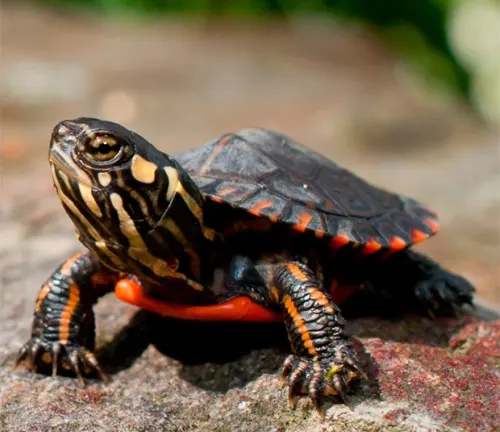
These omnivorous turtles have a diverse diet consisting of aquatic plants, algae, insects, small fish, and crustaceans, showcasing their adaptability to different food sources. During the breeding season, male Painted Turtles engage in elaborate courtship displays to attract females, leading to the nesting and incubation of eggs in sandy or gravelly soil. With their ability to thrive in diverse environments and their cultural significance in various indigenous cultures, Painted Turtles hold a special place in the natural world, serving as a colorful marvel of nature and a symbol of resilience and longevity.
| Specifications | Details |
|---|---|
| Scientific Name | Chrysemys picta |
| Common Name | Painted Turtle |
| Shell Color | Various shades of red, orange, and yellow |
| Shell Pattern | Intricate markings resembling brush strokes |
| Habitat | Freshwater habitats such as ponds and lakes |
| Distribution | North America, from southern Canada to Mexico |
| Diet | Omnivorous, feeds on plants, insects, and fish |
| Size | Typically 4 to 10 inches in length |
| Lifespan | Up to 30 years or more in the wild |
| Reproduction | Egg-laying species, nests in sandy soil |
| Conservation Status | Varies by subspecies, some are threatened |
Painted Turtle: A Colorful Marvel of Nature
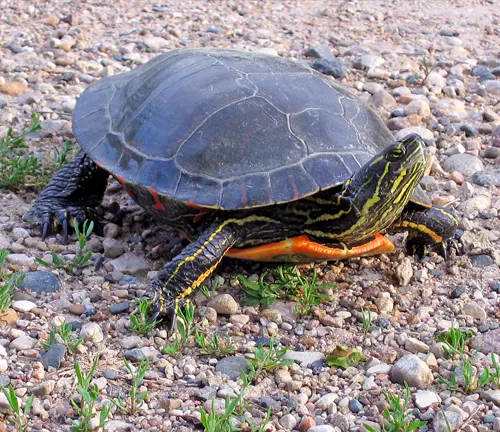
Painted Turtles, scientifically known as Chrysemys picta, are a charming species of freshwater turtles native to North America. These captivating creatures are known for their vibrant shell patterns and striking colors, making them a favorite among wildlife enthusiasts.
Physical Characteristics
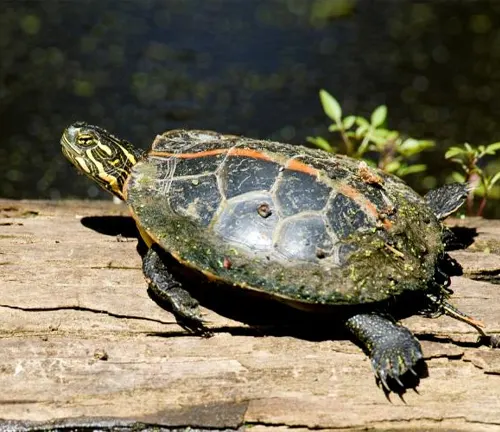
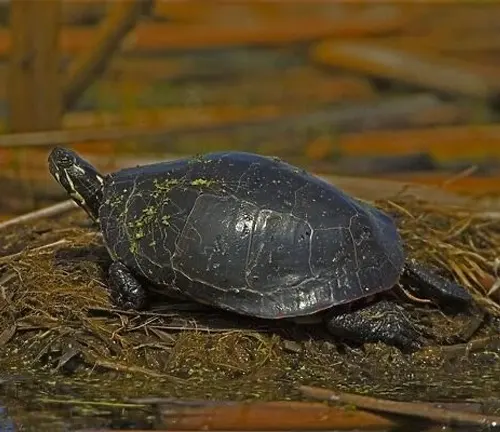
Painted Turtles, exhibit several distinctive physical features. One of their most striking attributes is their colorful shell, or carapace, which boasts vibrant hues of red, orange, and yellow. These markings often resemble brush strokes or intricate patterns, giving each individual turtle a unique appearance. The shell itself is relatively flat and smooth, providing the turtle with agility and maneuverability in water.
Habitat and Distribution
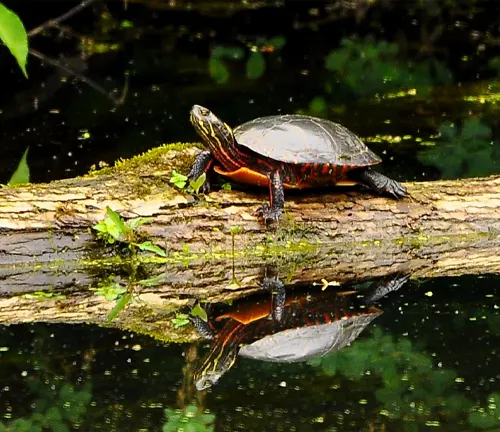

Painted Turtles are primarily found in North America, spanning a wide range of habitats from southern Canada to northern Mexico. They are highly adaptable and can thrive in various freshwater environments, including ponds, lakes, marshes, and slow-moving streams. These turtles prefer habitats with ample sunlight, abundant vegetation, and access to both water and basking sites.
In their natural habitat, Painted Turtles can be observed basking on logs, rocks, or vegetation along the water’s edge, soaking up the warmth of the sun. They are also known to burrow into the mud or substrate at the bottom of water bodies during periods of dormancy or hibernation, providing them with protection from harsh weather conditions.
The distribution of Painted Turtles varies among different subspecies, each adapted to specific geographic regions and environmental conditions. For example, the Eastern Painted Turtle (Chrysemys picta picta) is commonly found in the eastern United States and parts of Canada, while the Western Painted Turtle (Chrysemys picta bellii) inhabits the western regions of North America.
Diet and Feeding Habits

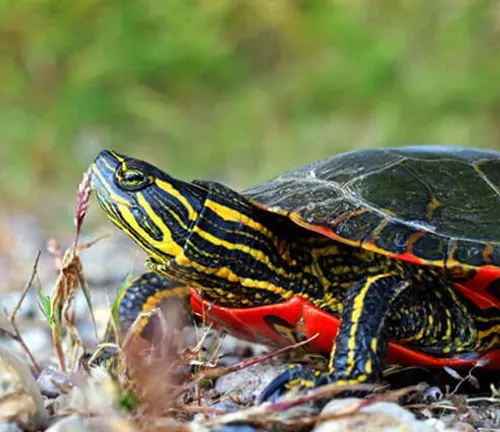
Painted Turtles are omnivorous reptiles with a diverse diet that reflects their adaptability to different environments. Their feeding habits vary depending on factors such as habitat, availability of food sources, and seasonal changes. Here’s an overview of the diet and feeding habits of Painted Turtles:
- Plant Matter: Painted Turtles consume a variety of aquatic plants, including algae, pondweed, duckweed, and water lilies. These plants provide essential nutrients and fiber to their diet and are often foraged while swimming or basking near the water’s surface.
- Insects and Invertebrates: In addition to plants, Painted Turtles feed on a wide range of insects and invertebrates found in their aquatic habitats. This may include aquatic insects such as dragonfly nymphs, mosquito larvae, aquatic beetles, and snails. They use their sharp beaks to capture and consume these prey items.
- Small Fish and Amphibians: Painted Turtles are opportunistic feeders and will also consume small fish, tadpoles, frogs, and other amphibians if available. They may hunt for these prey items while actively swimming or by ambushing them near the water’s edge.
- Carrion and Scavenging: Painted Turtles are known to scavenge for carrion and dead animals floating in the water or washed up on shorelines. This behavior allows them to supplement their diet with additional protein and nutrients, especially during periods of food scarcity.
- Feeding Behavior: Painted Turtles are primarily active during the day, spending much of their time basking in the sun to regulate their body temperature. They are often observed foraging for food in shallow water or along the bottom of their aquatic habitats. Painted Turtles use their keen sense of smell to locate prey and may employ a sit-and-wait strategy to ambush unsuspecting prey as it passes by.
Reproduction
Painted Turtles, native to North America, embark on a captivating journey of reproduction each year. During the breeding season, which typically occurs in spring or early summer, male Painted Turtles engage in elaborate courtship displays to attract potential mates. This may involve swimming alongside females and gently nudging them or displaying their vibrant colors to showcase their suitability as a mate. Once courtship is successful, females seek out suitable nesting sites, often sandy or gravelly areas near water bodies. Here, they lay clutches of eggs, carefully burying them to protect them from predators and the elements. The incubation period varies depending on environmental conditions, with hatchlings emerging from their eggs ready to embark on their own adventures.
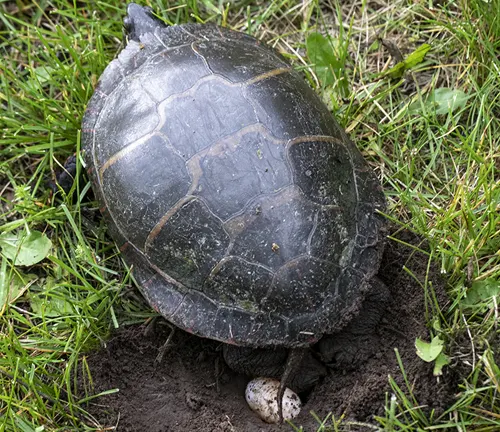
Lifecycle
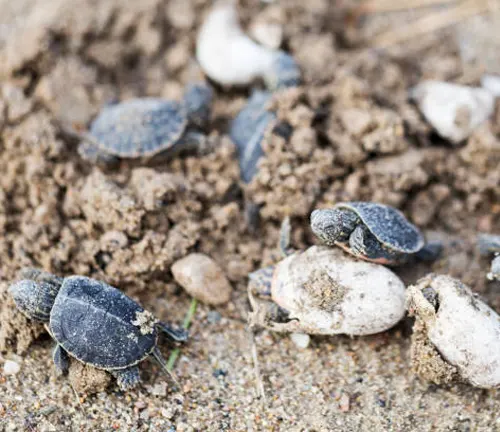
The lifecycle of Painted Turtles is a testament to their resilience and adaptability. From the moment they hatch from their eggs, Painted Turtle hatchlings embark on a perilous journey, navigating the challenges of their environment to reach maturity. As they grow, Painted Turtles undergo various developmental stages, each marked by distinct changes in their physical appearance and behavior. They spend much of their time basking in the sun to regulate their body temperature and foraging for food in their aquatic habitats. With proper care and favorable conditions, Painted Turtles can live for several decades, enriching the ecosystems they inhabit with their presence.
Adaptations
Painted Turtles have evolved a remarkable array of adaptations to thrive in their diverse habitats. One of their most notable adaptations is their colorful shell, which serves as both camouflage and a form of communication. The vibrant hues of red, orange, and yellow help Painted Turtles blend in with their surroundings, making them less visible to potential predators. Additionally, Painted Turtles have developed specialized glands for excreting excess salt, allowing them to inhabit both freshwater and brackish environments. Their streamlined body shape and webbed feet enable them to move gracefully through the water, while their sharp beaks aid in capturing prey and tearing food.

Predators and Threats
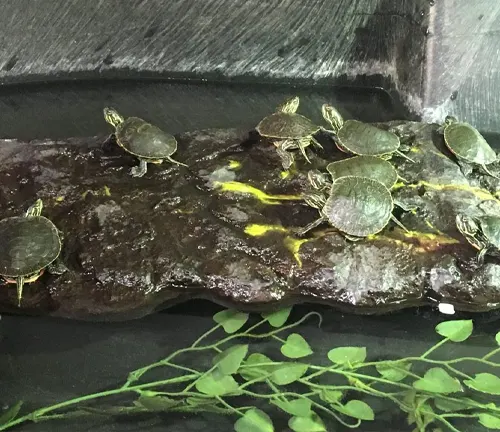
Despite their adaptations, Painted Turtles face numerous threats from predators and human-induced activities. Natural predators such as raccoons, birds of prey, and larger aquatic predators pose significant risks to Painted Turtle eggs, hatchlings, and adults. Additionally, habitat loss, pollution, urbanization, and illegal collection for the pet trade threaten the survival of Painted Turtle populations. Conservation efforts aimed at preserving and restoring freshwater habitats, implementing regulations on captive breeding and trade, and raising awareness about the importance of Painted Turtles in ecosystems are crucial for ensuring their continued existence in the wild.
Conservation Status
While Painted Turtles are not currently listed as endangered, some subspecies are considered threatened or of special concern due to declining populations. Conservation efforts focus on preserving their natural habitats, implementing regulations on captive breeding and trade, and raising awareness about their importance in ecosystems.
Interaction with Humans
Painted Turtles play a vital role in maintaining the health of freshwater ecosystems by controlling populations of aquatic plants and insects. However, human activities such as urbanization, pollution, and habitat destruction pose significant challenges to their survival.
Symbolism and Cultural Significance
Throughout history, Painted Turtles have held symbolic significance in various indigenous cultures, representing longevity, wisdom, and resilience. Their colorful appearance and gentle demeanor have inspired artists, storytellers, and poets for centuries.
Interesting Facts
- Painted Turtles are excellent swimmers and can travel long distances over land to find suitable habitats.
- Unlike some turtle species, Painted Turtles are not known for vocalizations but communicate through body language and tactile cues.
- In colder climates, Painted Turtles enter a state of hibernation during the winter months, burying themselves in mud at the bottom of ponds or lakes.
Keeping Painted Turtles as Pets
While Painted Turtles are fascinating creatures, they require specific care and attention to thrive in captivity. Prospective pet owners should research their dietary needs, habitat requirements, and legal regulations before acquiring one. It’s essential to ensure that captive turtles are sourced ethically and not taken from the wild illegally.
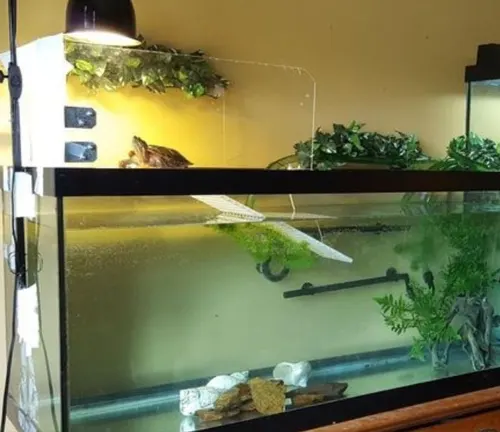
Tips for Conservation
Individuals can contribute to the conservation of Painted Turtles and their habitats by:
- Supporting organizations dedicated to turtle conservation.
- Participating in habitat restoration projects.
- Educating others about the importance of preserving freshwater ecosystems.
Different Species
Eastern Painted Turtle
(Chrysemys picta picta)
Found in the eastern United States and parts of Canada, this subspecies of Painted Turtle is known for its vibrant shell markings and is commonly seen basking on logs or rocks in ponds and marshes.

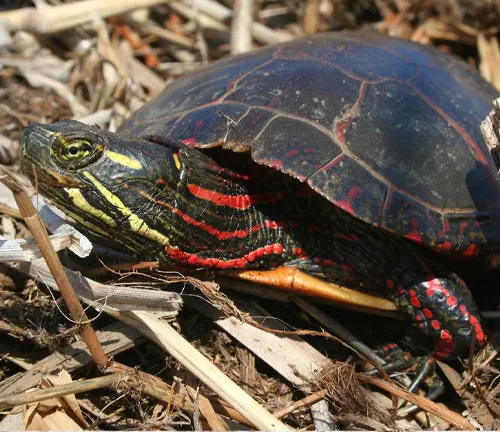
Midland Painted Turtle
(Chrysemys picta marginata)
Native to the central United States, the Midland Painted Turtle has a distinctive yellow or orange stripe down the center of its carapace, distinguishing it from other subspecies.
Western Painted Turtle
(Chrysemys picta bellii)
Inhabiting the western regions of North America, including parts of the United States and Canada, the Western Painted Turtle has a darker shell and is often found in slower-moving bodies of water.

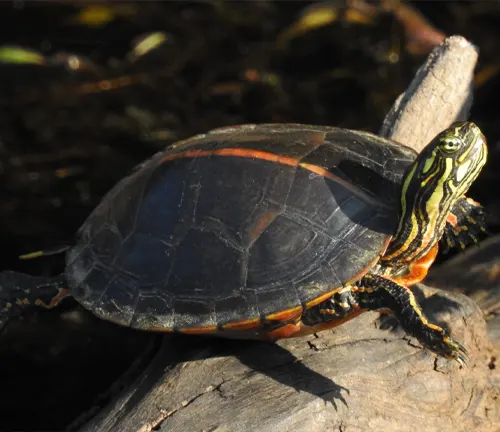
Southern Painted Turtle
(Chrysemys dorsalis)
Found in the southeastern United States, particularly in Florida, the Southern Painted Turtle has a unique pattern on its shell and is well adapted to warmer climates.
Frequently Asked Questions (FAQs)
- What do Painted Turtles eat?
Painted Turtles are omnivores and consume a varied diet consisting of aquatic plants, algae, insects, small fish, and crustaceans. - Where do Painted Turtles live?
Painted Turtles inhabit freshwater habitats such as ponds, lakes, marshes, and slow-moving streams across North America. - How long do Painted Turtles live?
In the wild, Painted Turtles can live for several decades, with some individuals reaching ages of 30 years or more. - Are Painted Turtles good pets?
Painted Turtles can make interesting pets for experienced reptile keepers who can provide them with proper care and habitat. - Do Painted Turtles hibernate?
Yes, Painted Turtles hibernate during the winter months by burying themselves in mud at the bottom of ponds or lakes. - Are Painted Turtles endangered?
While some subspecies of Painted Turtles are threatened or of special concern, the overall population status varies by region. - Can Painted Turtles be kept in outdoor ponds?
Yes, Painted Turtles can be kept in outdoor ponds if the habitat meets their specific requirements for temperature, filtration, and predator protection. - Do Painted Turtles need special lighting?
Painted Turtles benefit from access to UVB lighting to aid in calcium metabolism and shell health, especially in captive environments. - How can I tell the gender of a Painted Turtle?
Male Painted Turtles typically have longer and thicker tails compared to females, which have shorter and narrower tails. - Can Painted Turtles be handled?
While Painted Turtles can be handled occasionally, it’s essential to minimize stress and handle them gently to avoid injury.


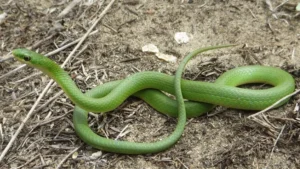
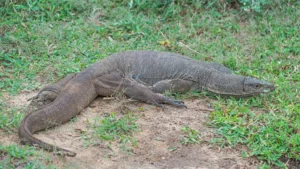
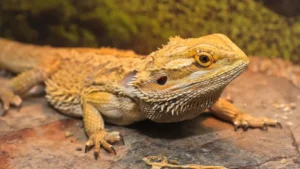

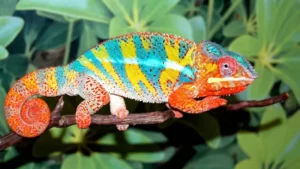


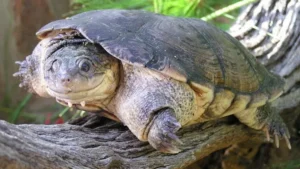

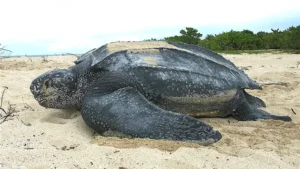

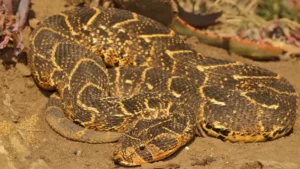
Leave your comment